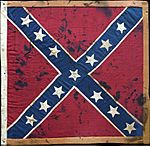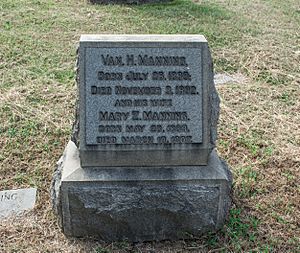Van. H. Manning facts for kids
Quick facts for kids
Van. H. Manning
|
|
|---|---|
 |
|
| Member of the U.S. House of Representatives from Mississippi's 2nd district |
|
| In office March 4, 1877 – March 3, 1883 |
|
| Preceded by | G. Wiley Wells |
| Succeeded by | James R. Chalmers |
| Personal details | |
| Born |
Vannoy Hartrog Manning
July 26, 1839 Wake County, North Carolina |
| Died | November 3, 1892 (aged 53) Prince George's County, Maryland, U.S. |
| Resting place | Glenwood Cemetery, Washington, D.C. 38°55′23.1″N 77°00′20.7″W / 38.923083°N 77.005750°W |
| Political party | Democratic |
| Spouse | Mary Z. Manning |
| Relatives | Levi H. Manning (son) |
| Alma mater | University of Nashville |
| Military service | |
| Allegiance | |
| Branch/service | |
| Years of service | 1861–1865 |
| Rank | |
| Commands | 3rd Arkansas Infantry Regiment (1862–64) |
| Battles/wars | American Civil War |
Vannoy Hartrog Manning (born July 26, 1839 – died November 3, 1892) was an important figure in American history. He served as a U.S. Representative for Mississippi from 1877 to 1883. Before becoming a politician, he was a Colonel in the Confederate Army during the American Civil War. He was wounded and captured during the war.
Contents
Early Life and Education
Vannoy Manning was born in 1839 in Wake County, North Carolina. When he was two years old, his family moved to Mississippi. He went to a private school called Horn Lake Male Academy in De Soto County.
Later, Manning studied law at the University of Nashville in Tennessee. After finishing his studies, he and his wife moved to Arkansas in 1860. In 1861, he became a lawyer and started his own practice in Hamburg.
Serving in the American Civil War
In May 1861, Manning helped to create the 3rd Arkansas Infantry Regiment. This group was made up of soldiers from several counties in Arkansas, plus some from Tennessee and Kentucky.
The regiment went to Vicksburg, Mississippi, hoping to join the Confederate Army. At first, they were turned away. But with help from an Arkansas politician named Albert Rust, the regiment was accepted. They were sent to Virginia for training and became part of General Robert E. Lee's Army of Northern Virginia. This meant they fought in many of the major battles in the eastern part of the war.
Manning started as a Captain. He was later promoted to Colonel of the Third Arkansas. He was wounded three times during the war: at the battles of Antietam, Gettysburg, and The Wilderness.
Manning's Bravery in Battle
Colonel Manning became known for his bravery. He was praised in official reports for his actions at the Battle of Antietam. Confederate General John G. Walker wrote about how Manning and his soldiers bravely charged forward, driving the enemy back. However, they faced strong fences and heavy enemy fire, which made it impossible to continue. Manning was seriously wounded during this fight and had to leave the field.
He was also commended for his courage at the Battle of Gettysburg. His regiment, the Third Arkansas, helped capture an important area called Devil's Den. Even though they faced many challenges and suffered losses, Manning's leadership helped them succeed. He was wounded again during this battle while helping his regiment hold their position.
In 1864, Manning was wounded a third time and captured by Union forces during the Battle of the Wilderness in Virginia. He was held as a prisoner of war until the war ended. By the end of the war, only 144 of his 1,353 soldiers from the Third Arkansas had survived.
Life After the War
After the Civil War, Manning moved to Holly Springs, Mississippi. He started practicing law again. In 1876, he entered politics as a Democrat.
He was elected to represent Mississippi's 2nd congressional district in the U.S. House of Representatives. He served three terms, from March 4, 1877, to March 3, 1883.
In 1883, he tried to get elected for a fourth term, but his opponent, James R. Chalmers, challenged the election results. Manning then moved to Washington, D.C. and continued his law practice. In 1884, Congress decided that Chalmers had won the election. Manning then left politics and focused on his law career.
Vannoy Hartrog Manning passed away on November 3, 1892, in Prince George's County, Maryland. He was buried in Glenwood Cemetery in Washington, D.C..
Family Life
Vannoy Manning was married to Mary Z. Wallace. They had eight children together, four sons and four daughters. Their first son died when he was very young. Their second son, Levi H. Manning, later became the mayor of Tucson, Arizona.
See also
 In Spanish: Van H. Manning para niños
In Spanish: Van H. Manning para niños




